 |
Camp FawcettTroop on the way to Camp Fawcett in
1929 by bus. J. Q. McCorkle, Chairman of the committee, made the report of the campsite location committee to the board on March 20, 1928. He stated that a site on the Nueces river, one mile from Barksdale and forty-seven miles northwest of Uvalde on the Rocksprings Highway, had been selected, as this site met most of the twenty-one requirements of the National Office. Site Offered by BarksdaleA well was to be dug on the site by the folks of the community for the Scouts. Upon hearing the report of the committee, the board voted to have the summer camp between August 1-7, 1928, and that the name of the camp be "Camp Fawcett on the Nueces." Tent For President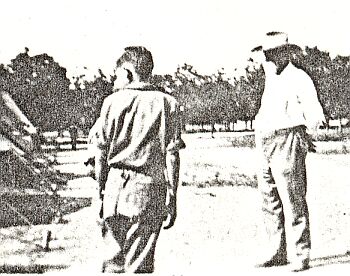 A tent for the
president would be erected and a large sign that read
"E. K. FAWCETT, PRESIDENT, SOUTHWEST TEXAS COUNCIL"
would be placed before the tent. The camp fee
was $7.50. A road was built into the camp, a
trolley placed over the swimming hole and spring board
rafts were installed. A bridge was built over
the ravine, and water was piped from the new well to
the camp kitchen. A tent for the
president would be erected and a large sign that read
"E. K. FAWCETT, PRESIDENT, SOUTHWEST TEXAS COUNCIL"
would be placed before the tent. The camp fee
was $7.50. A road was built into the camp, a
trolley placed over the swimming hole and spring board
rafts were installed. A bridge was built over
the ravine, and water was piped from the new well to
the camp kitchen.
E. K. Fawcett was a frequent visitor to camp. He is shown the right side of this photo. One hundred and fifty boys spent a week at the camp. K. N. Clapp of Lubbock ran the waterfront and Chief Red Eagle of Roswell, New Mexico, who had helped out at Camp Cypress the year before, was there to assist. H. B. Palmer, Scout Executive, was the Camp Director. An ex-army cook, and his corps of assistants provided the meals for the camp. At the end of the week of camp, 1,500 attended a picnic there on August 7. Their regular quarterly meeting of the Council Executive Board was held at the camp on the same day as the picnic. Rocksprings Chamber of Commerce Responsible for Camp
The San Angelo Morning Times, dated September 4, 1928, page 3, reported that (in reference to Camp Fawcett) "This movement was started by the Edwards County Chamber of Commerce some two months ago and Mr. Brown placed at the head of the movement by the body." In January of 1929, V. A. Brown, now Camping Chairman of the council, made a report to the board at its Fourth Annual Meeting, concerning the troubles they were having in acquiring title to the Camp Fawcett property. The board elected Brown as trustee of the funds that had already been collected for the camp and directed that they be placed on time deposit in the First National Bank of Rocksprings.
Shown on the left is the first mess hall. Nelson helped build the brush arbor used for the first mess hall that first summer. It was located near oak trees on the bluff where Frontier campsite is located today. They cut Sycamore trees near the river and used the big part of the trees for upright posts for the arbor. The
smaller limbs were used for the roof and the limbs
with leaves on them were used to cover the
roof. The arbor was "about 30' wide and 75'
long," according to Nelson. They cooked on
wood stoves outside the arbor and brought water from
the river and stored it in wooden
barrels. This was the only building in
camp. Bruce Ivey took the photo in 1928.
The tents were pitched on the flats below the present dining hall in a semi-circle. They had about 15 tents. This photo was taken at the first camp in 1928. Left to right: Scottie Pegues, Marion Harkey and Welbourne Gardner. Bruce Ivey took the picture. In addition, Chief Red Eagle pitched his tee-pee with real skins over the frame. The tee-pee was located about 100' South of the present First Aid Lodge. He brought his wife with him. They were from Ruidoso, New Mexico, a white boy who had been captured by the Indians. He
remembers them gathering on the flat below the
tee-pee for campfires each evening and taking
evening hikes up the gully to the NW side of
camp. These were called "survival hikes" as
they had to find horned toads, grasshoppers, etc. to
eat.
The swimming area had three diving boards. One was four feet above the water, one ten feet, and one was twenty feet. There were a pond and spring located north of the swimming area where they could catch bass. Bruce Ivey took this picture of the swimming area from the bluff in 1928. Ivey was at Camp Fawcett from 1928 to 1936. He remembers K. N. Clapp, a cotton Broker from Lubbock, who was waterfront director and brought his Scouts for several years to work at the camp. They had
no archery targets or bows but learned to make
arrows while in camp. Camp Fawcett - 1929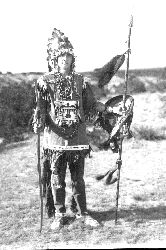 The summer camp
opened on Wednesday, August 7, 1929, at 9 a.m. for ten
days. The fee was again $7.50 with the leaders
coming free. One hundred and eighty Scouts
attended this session of camp under the direction of
Scout Executive H. B. Palmer. The summer camp
opened on Wednesday, August 7, 1929, at 9 a.m. for ten
days. The fee was again $7.50 with the leaders
coming free. One hundred and eighty Scouts
attended this session of camp under the direction of
Scout Executive H. B. Palmer.
One of the features of this year's camp was the visit of F. H. Lehman of Mason, who as a lad of 11 years of age, was captured by a roving band of Apache Indians, and remained as a member of that and the Comanche tribes until 20 years of age when he was returned to his mother. His story of his adventures was told at the evening campfires. K. N. Clapp of Lubbock, executive of the South Plains Council, together with four Eagle Scouts from that Council, directed the waterfront activities, as well as a camp museum. He is showed on the right in his Indian Outfit. Others on the staff were a Mr. Worley and Mr. Picnot of the Central Power and Light Company and Chaplain John MacWilliam of Fort Clark. Airplane Landing Field BuiltR. J. Nelson of Camp Wood, remembers when the landing field was built. The round rocks, which were about the size of one’s head, were brought to the site in old Chevy or Ford trucks up from Lover's Lane in Barksdale. The trucks could only carry about twelve rocks at a time. Landing Field Sign Still ExistsWe learned that the old highway from Rocksprings came down the west side of the camp property line before turning east and heading into Barksdale. The sign was located only about 20' east of the dirt road. We also discovered a rock pile marker located on the east side of the landing field to tell flyers where the end of the field was. The flyers landed over the side coming in from the west. George Gobel made a video of the sign and our search for the site. Came From Several TownsHondo -
9 Barksdale - 8 Carrizo
Springs - 6 Camp Fawcett - 1930Deed ClosedThe summer camp was held during the week of August 4-14, 1930. By that summer camp the 32-foot deep well had been curbed and concrete topped to prevent contamination and a Fuller and Johnson engine had been installed to pump water from the well. The sanitary system had been installed and housed. Mess Hall Built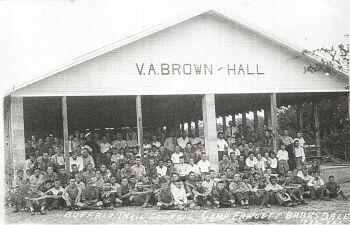 The first permanent building
was completed in time for camp that same summer.
A mess hall forty by twenty feet was built with a
sixteen by twenty-eight foot kitchen and a store
room. The mess hall was built of reinforced
concrete, railroad timbers, and covered with
corrugated iron along with tables and shelving.
The kitchen was screened, but the mess hall was
not. (The concrete floor for the dining hall was
poured in July, 1931. The unskilled labor was
furnished by the neighbors and the men and boys from
Buffalo Trail Council, Sweetwater, Texas, who helped
with the concrete in return for use of the camp that
summer. The floor finishers and the carpenter
agreed to work for $1.50 per day. The original
dining hall is still in use today.) The first permanent building
was completed in time for camp that same summer.
A mess hall forty by twenty feet was built with a
sixteen by twenty-eight foot kitchen and a store
room. The mess hall was built of reinforced
concrete, railroad timbers, and covered with
corrugated iron along with tables and shelving.
The kitchen was screened, but the mess hall was
not. (The concrete floor for the dining hall was
poured in July, 1931. The unskilled labor was
furnished by the neighbors and the men and boys from
Buffalo Trail Council, Sweetwater, Texas, who helped
with the concrete in return for use of the camp that
summer. The floor finishers and the carpenter
agreed to work for $1.50 per day. The original
dining hall is still in use today.)
R. J. Nelson said that when the mess hall was built, it had a dirt floor, no screening and no water or electricity. He worked in the mess hall the first year it was built and remembers cutting wood for the stoves. The kitchen crew lived in tents located behind the dining hall on the north side. He believes the tables had metal tops and separate benches for seating. All the equipment for camp came for San Antonio and was World War I surplus, including the tents they stayed in. At the August 12, 1930, Executive Board Meeting, held at Camp Fawcett during summer camp, the board approved naming the dining hall as the "V. A. Brown Hall" in honor of Brown's efforts in obtaining the camp property. The camp fee was $8.00, or $1.00 per day. The first two days of the summer camp were set aside for camp leader training and the following eight days for the Scouts. Materials for Mess HallRepublic
Portland Cement Company - 528 sacks of cement
First “Camp Ranger"Camp Fawcett - 1931A well was dug just east of the present First Aid Lodge and they had a small storage tank located just north of the well. Water had to be carried everywhere in camp including to the dining hall. The concrete top of the well is still visible today at the site. The food was prepared by two cooks, and assisted by two helpers. It was noted in the report that the cooks were handicapped by the old field ranges that they had to cook on. Milk and butter were sent up from Uvalde daily and veal and mutton were killed locally. The groceries were bought in Uvalde. Kid Ran Over By Model T FordCamp Newspaper ProducedFourteen Scouts passed Junior Life Saving, and eight passed Senior Life Saving during that week of camp. The charge for the camp was $6.00 per boy and leader. Salaries were paid only to the cooks. Chief Red Eagle was paid for his traveling expenses to and from the camp. U. S. Chaplain John MacWilliams was the Camp Director, with H. B. Palmer, Scout Executive, in charge of details and Chief Red Eagle in charge of Indian lore. In addition, about twenty-four leaders were present during the camp. No mention was made of how many Scouts attended the camp. The daily program schedule was as follows: 6:00 a.m.
First Call A "History of Camp Fawcett," prepared by H. Robert McNiel of Uvalde, stated that on December 5, 1947, 24.39 acres of the land was sold to Neal Jernigan of Barksdale for the amount of $609.75 with the Granter retaining one half rights to all Oil, Gas and other Minerals on this tract of land. Sam H. Walk, of Del Rio, was president of the Concho Valley Council at that time. On January 9, 1948, 102.16 acres of land lying south and west of the then Highway 55 was sold to Neal Jernigan of Barksdale for $25.00 per acre, for a total of $2,554.00. The Concho Valley Council still owns approximately 173.45 acres of land and still using the camp for summer camp each year and for numerous other activities. Improvements at camp
That same
spring, the Rocksprings-Nueces Canyon Telephone
Company sent equipment to camp and drilled more than
100 post holes to be used for fencing as well as set
up temporary latrines for use at the various
campsites that summer of 1971. Another new shower and restroom facility were built in the north part of the camp. Prior to that time, the only facilities for use by the campers were located at the waterfront and at an old white latrine on the bluff overlooking the canoeing area. The facility was build by Sam Fish of Barksdale in 1977. A much needed restroom was added on to the cook’s cabin in 1978 in time for summer camp. Prior to that time the cooks only had one room and had to go outdoors to shower and to the dining hall to use the restroom. The new room featured a sink, tub with shower and flush commode.
With the building of the new quartermaster, the staff area had to be relocated as it used to be clustered around the concrete slab. So, in 1982, a new area was carved out by the Order of the Arrow about a block from the quartermaster/staff latrine and platforms were built along with electricity to each platforms. A couple of platforms were built each year until enough were built to accommodate the staff. The 47th Air Force Civil Engineers from Laughlin Air Force Base came back to Camp Fawcett in 1982. They took the old roof off the Brown Lodge Dining Hall, insulated the ceiling in the Trading Post and added sheetrock, as well as painted the outside of the Trading Post and Liberty Campsite Latrine. They also had time to build a new shotgun storage cabinet at the shotgun range. They were back at camp in 1983 to continue their work of carpentry, painting, checking out refrigeration units, plumbing and doing general cleanup work at the camp. During that same year, a new flammable liquid storage shed was built; all wiring in the health lodge, dining hall, office, swimming area shower and white latrine was put in conduit; and new storeroom shelving was built in the dining hall.
His parents, Ruth E. and Howard S Martindale, contributed $25,000 to build the waterfront including ladders, diving board and lookout tower. Lee Allison of Rocksprings built a strong fence around the swimming area at the top of the bluff and also designed and built the memorial plaque. FloodsAfter a flood on the river in 1981, a retaining wall was constructed at both ends of the swimming area and concrete was poured eight feet up the side of the hill between the walls to protect the concrete slab against future flooding. In 1986, an additional eight to thirty feet of concrete was poured at the swimming area. The additional footage was poured to provide additional protection against erosion of the embankment. Bob McNeil and Troop 81 of Uvalde contributed $2,500 to the project. A new entrance to camp was started in 1981 and was finally completed and dedicated on April 5, 1986, in the memory of Homer A. Smith, former Chairman of the Fawcett Development Committee, by the Smith family. The entrance was built by his son, Ray Smith, over a period of five years. A new lady’s restroom and shower facility was started at Camp Fawcett in 1989. It was finally completed and dedicated in 1992. Always A Highlight Adventure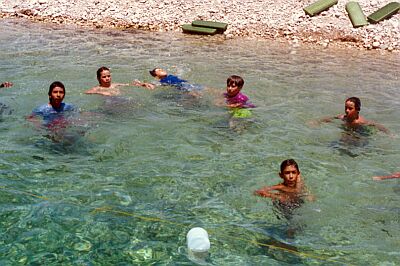 Summer camp has
always been a highlight adventure for Scouts in the
council. In the August 1972 issue of the
council’s newsletter, BOYPOWER, a recap of that year’s
summer camp was printed on the first page. It
pretty well sums up many of the adventures a boy
experiences at summer camp: Summer camp has
always been a highlight adventure for Scouts in the
council. In the August 1972 issue of the
council’s newsletter, BOYPOWER, a recap of that year’s
summer camp was printed on the first page. It
pretty well sums up many of the adventures a boy
experiences at summer camp:
“The Concho Valley Council’s two camps, Camp Sol Mayer and Camp Fawcett, look pretty deserted right now. The grass is growing tall once again, and the sounds of boys and Scoutmasters are stilled. The dining halls are resuming their dusty, unused look - and the scarce wildlife has returned in abundance now that the old familiar sounds of camping are gone. “It is hard to realize that over 750 boys attended the two camps this summer, and this does not include the many Scoutmasters and Assistant Scoutmasters and the other good men who acted as Scoutmasters for a week, and this does not include the Philmont and Canadian Canoe Trippers. The thirty-two members of the staff have returned home, to school or have started treks around the good old U. S. A. “The office realizes that may boys were in camp - they have processed the zillion merit badge applications completed at camp, recorded the advancement of many of the boys and heard many of the tales that come out of each summer camping experience (from boys, leaders and staff members alike) such as the oatmeal at Sol Mayer being so resilient that it defied all efforts to get a spoon into it. Who knows, we may have found a new paving material for our highways. We also heard of the new water system at Camp Fawcett defying all efforts to get the water to run from the hydrants - when it is supposed to run.
“The camp directors and the program director were extremely pleased with the number of campers - but wish even more boys could have attended. “The High Adventure' groups at both camps posed challenging problems this year, since this was a new experience. Tommy McSwain and Russ Tidwell will both agree that rubber life rafts absolutely will not hold air when punctured in midstream. Over sixty of the older boys joined the high adventure group this summer - and the staff is really happy about the turnout. The first group on the trip down the Llano River can take pride in the fact that they were the pioneers - and they really had a ball! We learned a lot this summer - and already, plans are being made for another high adventure trip next year - with the possibility of a different type of adventure. Anyone for hot air ballooning? “Council and District Camping and Activity Committees are screening the results of this years' summer camp experiences and are planning ahead for the 1973 camping season right now. This will include two 1973 Jamborees, the Canadian Canoe Trip, Philmont and other treks by units.
“Camp Fawcett played host to two Scout Troops from Monclova, Coahuila, Mexico. The two Troops combined had a total of 23 Scouts and 3 leaders. Acting as Scoutmaster for the combined units was Francisco Alfaro Lopez. Scouts in attendance at Fawcett during the week Troop 4 was in camp received a taste of international Scouting. From all reports everyone enjoyed this week - except for several staff members who had to act as interpreters, racing from one activity to the rest in order to help our visitors and staff in their activities. Needless to say - we look forward to their return in the future.” Note: Francisco Alfara Lopez did bring his troop back to Camp Fawcett for several more years. The last year he was at the camp, they had some 50 Scouts, all in complete uniform. It was always a pleasure to have these Scouts as part of the summer camp program. Summer Camp Discontinued in 1997 - 2000Camp was again not used for summer camp after 2000 until 2013 when a special camp was use from June 16 - 22, 2013 in Memory and Honor of Taylor and Thomas Nunley who met an untimely passing in July 2012 and their dedication to Scouting. Each troop cooked its own meals and there was a central staff there to provide merit badge instruction and other activities. The Shawee Indian Dancers of Uvalde came out and performed for the camp. The camp was once again a BSA National Accredited Camp. The Camp Sol Mayer Ranger used to go down once a month and opened the camp for Troop weekend camping. The camp is still used for District Camporees, Cub Camps, Order of the Arrow, and other weekend activities. Although the camp no longer has a week long summer camp experience for youth, they hosted a weekend Scout Camporee March 25-27, 2022, and a weekend Cub Camp April 22-24, 2022, in addition to having units camp there on weekends. The physical facilities at Camp Fawcett have been improved. A grant was received that allowed the Texas Southwest Council to build a new restroom facility and paint the First Aid Lodge, as well as build a new trading post under the old trading post roof. During the summer of 2012, several of the old latrines, the cooks cabin and the old trading post were bulldozed. Merit Badge Encampment in 2005The eight Troops that participated were Troop 81, Uvalde; Troop 140, Kerrville; Troop 257, Bracketville; Troop 272, Del Rio; Troop 313, San Angelo; Troop 346, Uvalde; and Troop 402, Brady. Camp staff members were Dennis Luellen, Camp Director; Jared Ducote, Assistant Camp Director; Lisa Mahler, Program Director/Trading Post Manager; Wynn Alston, Aquatic Director; Stephen Meuth, Shooting Sports Director; Sandi Bertocci, Health and First Aid; and Mike Wallace, Camp Ranger. All other merit badge instructors were Scoutmaster and leaders of the individual troops. The Canoeing Merit Badge class took its final trip down the Nueces and got so tired that they couldn't canoe back. The merit badge instructor had to hike back to camp to get the truck and canoe trailer to return to pick up the class. The entire camp took a trip to Rocksprings, Texas, and had dinner at the local King Burger. They took up every seat in the place. Following dinner, they then went to the Devil's Sinkhole to watch some three million Mexican freetail bats fly out of a hole in the ground. For most of the Scouts this was the first time they had seen bats, much less three million of them at one time! This was the 75th Anniversary of the camp being deeded to the Southwest Texas Council (although the camp was actually first used as a summer camp in 1928). So, it was fitting to hold a rustic camp with patrol cooking, Scoutmasters teaching merit badges, much like what it would have been like in 1930. The Merit Badge Encampment was again held in 2006 but with a smaller turnout. The name was changed to "Outdoor Skills Workshop." Outdoor Skills Workshop was held at Camp Fawcett July 12-14, 2006. There were four troops in attendance. A total of 22 Boy Scouts participated. Eleven adults were on staff. Brad McCormick served as Camp director. The Scoutmasters taught Merit badges: Indian Lore, Rifle, Archery, First Aid, Fishing, American Culture, Emergency Preparedness and Citizenship in the Community. The Troops cooked their own food in their campsite. A commissary provided the food. Thursday night was family night. A fun campfire was held followed by an OA Call out. There were numerous visitors in camp for family night. Wood Badge Courses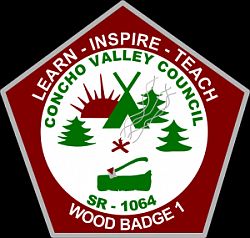 A couple of Wood
Badge courses have been held at Camp Fawcett over the
years. The first Wood Badge Course held by the
Concho Valley Council (now Texas Southwest Council)
was held at Camp Sol Mayer in 1975. The course was
SC-57 and was a seven-day outdoor training event. The
course was well attended by the Scouters of the
Council. In fact, the course was such a success
that a second course was held two years later at Camp
Fawcett June 4-11, 1977. The course number was
SC-104. A third course was held at Camp Sol
Mayer, SC-241, June 4-11, 1983. A couple of Wood
Badge courses have been held at Camp Fawcett over the
years. The first Wood Badge Course held by the
Concho Valley Council (now Texas Southwest Council)
was held at Camp Sol Mayer in 1975. The course was
SC-57 and was a seven-day outdoor training event. The
course was well attended by the Scouters of the
Council. In fact, the course was such a success
that a second course was held two years later at Camp
Fawcett June 4-11, 1977. The course number was
SC-104. A third course was held at Camp Sol
Mayer, SC-241, June 4-11, 1983.
The most recent one was Wood Badge for the 21st Century course held in the Texas Southwest Council (formerly Concho Valley Council) and was conducted in October 2010. The first phase of Wood Badge 1 was completed in the two council camps. Since this was the first Wood Badge for the 21st Century course in the Concho Valley Council, they also were “741-1" or “Wood Badge 1". The second weekend of the course was held at Camp Fawcett on October 29-31, 2010. Texas
Southwest Council Wood Badge 2 was officially
approved for course number S3-741-12! Bob Gardere
has been selected as the Course Director. His
mentor will be Dave Wakefield. The
course will be held in October 2012 on the second
and fourth weekends (October 12-14 and 26-28, 2012).
One of those weekends will again be held a Camp
Fawcett. It’s called Wood Badge 2 because this
is only the second Wood Badge for the 21st Century
course offered in Texas Southwest council. 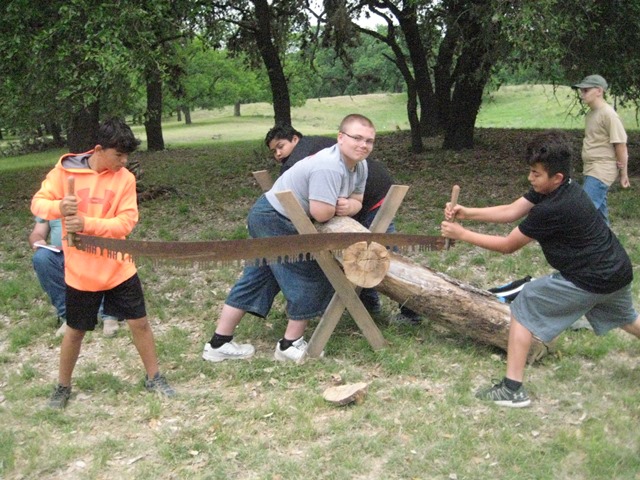
Frontier Days A "Mountain Man Rendezvous"
was held for some six years, 2013 to 2018.
Scouts from Del Rio, Eagle Pass, and Uvalde engaged
in the life of the original mountain men for a weekend. Contests included flint and steel fire making, rope climbing, log sawing,archery, axe thrown, target shooting, and bow and drill fire making. Goods Light Artillery was added to Frontier Days in 2018.
“Through the many years that I have served on camp staff, I have worked with hundreds of Scouts and Scouters as my coworkers and as my employees. But one staff member stands out in my mind from these many scouts that I have worked with. “The summer of 1990 was my second to serve on camp staff. It was a memorable summer for several reasons. First of all, Camp Director Frank Hilton assigned me to a brand new program for the summer called First Class Quest. This program would take in the boys that had not quite reached the rank of First Class, and would help them learn the skills to make progress on all of the ranks through First Class. As a CIT, I was excited for this opportunity to work in a new program area. But what really made the summer special was my area director, Jason Young. Jason was like any other Eagle Scout in many ways. He knew his skills, he was a leader and he loved working with the boys, but he was deaf. “I remember Jason from working the previous summer. He worked as the dining hall steward that year. I knew he was deaf then, but I never really got to know him. CITs usually only worked one week plus staff week, so I never had the opportunity. I do remember watching him ‘listen’ to the radio in the dining hall at Camp Fawcett during staff week of that first summer. He couldn't hear the music, but he could feel it vibrating the table, where his arms were resting. I'll always remember watching him ‘listen!’ “When I was assigned to work with Jason at First Class Quest, I wasn't sure how it would work. Frank told me of Jason's inability to hear, but also told me of his skills as a Scout. He wasn't wrong! Jason really knew his stuff, backwards and forwards. Jason could speak quite well, and could lip-read anybody that was speaking while facing him. At first, the kids in the classes didn't know how to deal with the situation...but after a few minutes, Jason would have them eating out of his hands. The kids loved him, respected him, and listened to him. “We made a great team that summer and became great friends. I looked up to him for many reasons. He was a great leader, a very skilled Scout and never his disability slow him down...not even for one second. “One of the greatest tributes to the work we did that summer came in 1996, my second year as Program Director for the Council. A scout came up to me and simply said ‘Thank You.’ 1990 was his very first summer camp, and he was a student in First Class Quest that year. He was now 17, had just graduated high school and was about to go off to be in the Navy. Now an Eagle Scout, he expressed how much he appreciated the attention that Jason and I gave him during his first year of camp. Without our help, he said he never would have become an Eagle Scout. “Working with scouts is a job that has few material rewards. Making a difference in a Scout's life is the best reward that can be received...and hearing the ‘thanks’ is all it takes for one to realize that difference. Jason made a difference in more than just that one scout's life. He made a difference in mine as well. Thank you, Jason!” We salute
all members of the summer camp staffs who, like
Jason, dedicated themselves to teaching the campers
their skills. And, we say a big “Thank You” to
those who prepared and served the food, worked in
the Trading Post, office, First Aid and all the
other support positions on the staff. You
truly made a difference in the lives of boys! | Maps of Camp Fawcett |
Last
updated: January 9, 2025 |
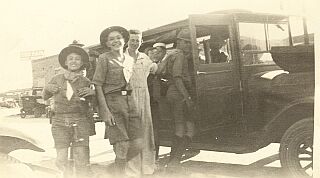 Early in 1928,
at the 3rd Annual meeting of the Southwest Texas
Council, President George E. Love explained to the
council the need for the council to have its own
property for a campsite and that a temporary site
would by needed for the coming summer. He
appointed a committee composed of I. Q. McCorkle, A.
B. Ewing, both of Del Rio; A. F. Smyth, Uvalde and
W. L. Guyler, of Eagle Pass to select a temporary
campsite for the summer and report back to H. B.
Palmer, Scout Executive.
Early in 1928,
at the 3rd Annual meeting of the Southwest Texas
Council, President George E. Love explained to the
council the need for the council to have its own
property for a campsite and that a temporary site
would by needed for the coming summer. He
appointed a committee composed of I. Q. McCorkle, A.
B. Ewing, both of Del Rio; A. F. Smyth, Uvalde and
W. L. Guyler, of Eagle Pass to select a temporary
campsite for the summer and report back to H. B.
Palmer, Scout Executive. 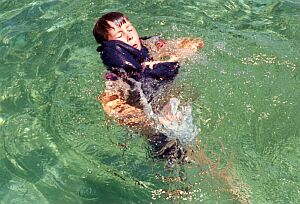 The board granted him 30 days in which to
report on the purchase of the land. Brown
placed $500 in escrow and had a contract drawn to
send to the owners for a purchase price of $8,500,
and which would be deeded to these organizations by
the Edwards County Chamber of Commerce as soon as
the necessary papers could be drawn.
The board granted him 30 days in which to
report on the purchase of the land. Brown
placed $500 in escrow and had a contract drawn to
send to the owners for a purchase price of $8,500,
and which would be deeded to these organizations by
the Edwards County Chamber of Commerce as soon as
the necessary papers could be drawn. 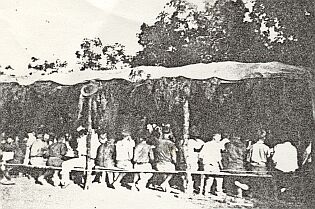 R. J. Nelson, a resident of Camp Wood,
took this author on a tour of Camp Fawcett on June
26, 1989, and showed him where the various
structures and activities were held when he went to
the camp in 1938 as a young boy.
R. J. Nelson, a resident of Camp Wood,
took this author on a tour of Camp Fawcett on June
26, 1989, and showed him where the various
structures and activities were held when he went to
the camp in 1938 as a young boy. 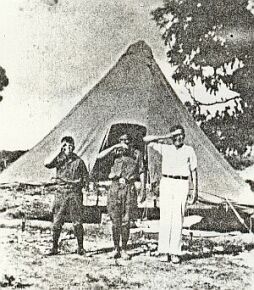
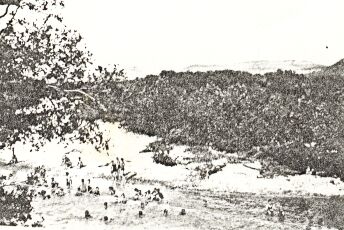
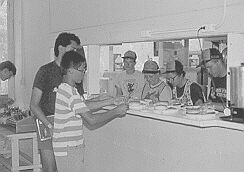 A new trading
post building was built at the camp in the spring of
1971 as a result of money being given by the estate
Lum Thompson. Lum Thompson had lived in
Barksdale, and upon his death the Lum Thompson
estate was established to fund projects at Camp
Fawcett. Claude Gilmer was
administrator of the estate. The trading post
was dedicated on June 17, 1971, during parents’
night at the camp. The old trading post,
located just below the dining hall, was turned into
the camp office.
A new trading
post building was built at the camp in the spring of
1971 as a result of money being given by the estate
Lum Thompson. Lum Thompson had lived in
Barksdale, and upon his death the Lum Thompson
estate was established to fund projects at Camp
Fawcett. Claude Gilmer was
administrator of the estate. The trading post
was dedicated on June 17, 1971, during parents’
night at the camp. The old trading post,
located just below the dining hall, was turned into
the camp office.